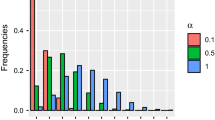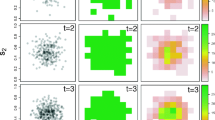Abstract
Estimation of population size has traditionally been viewed from a finite population sampling perspective. Typically, the objective is to obtain an estimate of the total population count of individuals within some region. Often, some stratification scheme is used to estimate counts on subregions, whereby the total count is obtained by aggregation with weights, say, proportional to the areas of the subregions.
We offer an alternative to the finite population sampling approach for estimating population size. The method does not require that the subregions on which counts are available form a complete partition of the region of interest. In fact, we envision counts coming from areal units that are small relative to the entire study region and that the total area sampled is a very small proportion of the total study area. In extrapolating to the entire region, we might benefit from assuming that there is spatial structure to the counts. We implement this by modeling the intensity surface as a realization from a spatially correlated random process. In the case of multiple population or species counts, we use the linear model of coregionalization to specify a multivariate process which provides associated intensity surfaces hence association between counts within and across areal units.
We illustrate the method of population size estimation with simulated data and with tree counts from a Southwestern pinyon-juniper woodland data set.
Similar content being viewed by others
References
Banerjee S, Carlin BP, Gelfand AE (2004) Hierarchical modeling and analysis for spatial data, vol 101, Monographs on statistics and applied probability. Chapman & Hall
Berliner LM (2000). Hierarchical Bayesian modeling in the environmental sciences. Allgemeines Statistisches Archiv, J German Stat Soc 84: 141–153
Cochran WG (1977). Sampling techniques. 3rd edn. Wiley, New York
Cressie NAC (1993). Statistics for spatial data (revised edition). Wiley, New York
Diggle P (2003). Statistical analysis of spatial point patterns. 2nd edn. Springer-Verlag, New York
Gelfand AE, Schmidt AM, Banerjee S and Sirmans CF (2004). Nonstationary multivariate process modeling through spatially varying coregionalization (with discussion). Test 13: 1–50
Gelfand AE, Zhu L and Carlin BP (2001). On the change of support problem for spatio-temporal data. Biostatistics 2: 31–45
Gelman A (1996) Inference and monitoring convergence. In: Gilks WR, Richardson S, Spiegelhalter DJ (eds) Markov chain and monte carlo in practice. Chapman & Hall, Boca Raton, pp 131–143
Gelman A and Rubin DB (1992). Inference from iterative simulation using multiple sequences (with discussion). Statist Sci 7: 457–511
Ghosh M and Meeden G (1997). Bayesian methods for finite population sampling. Chapman & Hall, London
Heikkinen J and Arjas E (1998). Non-parametric Bayesian estimation of a spatial Poisson intensity. Scand J Stat 25: 435–450
Luo Z and Wahba G (1998). Spatio-temporal analyses of temperature using smoothing spline ANOVA. J Climatol 11: 18–28
Moller J and Waagepetersen R (2003). Statistical inference and simulation for spatial point processes, no. 100, Monographs on statistics and applied probability. Chapman & Hall, Boca Raton
Rivoirard J, Simmonds J, Foote K, Fernandes P, Bez N (eds) (2000) Geostatistics for estimating fish abundance. Blackwell
Royle JA and Berliner LM (1999). A hierarchical approach to multivariate spatial modeling and prediction. J Agric Biol Environ Stat 4: 1–28
Thompson S (2002). Sampling. 2nd edn. Wiley, New York
Tobler W (1979). Smooth pycnophylactic interpolation for geographical regions. J Am Stat Assoc 74: 519–536
Wackernagel H (2003). Multivariate geostatistics: an introduction with applications. 3rd edn. Springer-Verlag, Berlin
Wakefield J and Salway R (2001). A statistical framework for ecological and aggregate studies. J Roy Stat Soc Ser A 164: 119–137
Wolpert R and Ickstadt K (1998). Poisson/gamma random field models for spatial statistics. Biometrika 85: 251–267
Author information
Authors and Affiliations
Corresponding author
Rights and permissions
About this article
Cite this article
Barber, J.J., Gelfand, A.E. Hierarchical spatial modeling for estimation of population size. Environ Ecol Stat 14, 193–205 (2007). https://doi.org/10.1007/s10651-007-0021-4
Received:
Revised:
Published:
Issue Date:
DOI: https://doi.org/10.1007/s10651-007-0021-4




